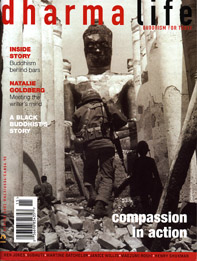The Koan
Texts and Contexts in Zen Buddhism
ed. Steven Heine and Dale S Wright
Oxford University Press, 2000
$19.95/£13.95p/b
The Koan exemplifies a paradox. It is a scholarly work on a Zen tradition that calls itself ‘a special tradition outside the scriptures, with no dependence upon words and letters’. In the popular imagination koans are equated with riddles – the best known is probably, ‘What is the sound of one hand clapping?’ But for a Zen practitioner, a koan is a question to meditate with, which enables them to develop a sense of perplexity. As the Zen traditions puts it: ‘Great questioning, great awakening; no questioning, no awakening’.
This book includes essays that cover everything you need to know about koans, and explore the controversies surrounding them. Zen Buddhism developed in China, a civilisation with a deep appreciation of literary pursuits and one that put great emphasis on keeping records. This is a boon for western and oriental scholars as it enables them to study the conditions that formed the Zen traditions over centuries. It means that the book is valuable not only for those interested in koans and Zen but also for people who want to know how a tradition constitutes itself, how it grows, and how it has described itself over time.
It also makes for a book of great scholarship – which is visible in its many pages of footnotes. (Personally, I love footnotes and these are full of interesting points and details – I read them as assiduously as the essays.) Such scholarship may not help much in koan practice on retreat or in daily life, but it does give a fuller context to that practice. And, as several essays point out, Zen masters are not against learning from texts, only against remaining locked in the words without being moved to practise.
The writers ask many questions. How did the koan first arise in China? What historical, social and cultural conditions influenced the development of the Zen tradition and the use of koan within it? An especially valuable aspect of the book is that it raises the profile of Tahui (1089-1163), a great Chinese Zen master who was impelled to devise an easier, more direct method to make practice accessible to his many disciples among the literati and functionaries in the Chinese government. Tahui initiated the way koans are used today, and the book shows how vital was his contribution to the development of the koan tradition.
Each essay brings something to this exploration of the koan, addressing a different facet of the story in China and Japan. My only reservation about this otherwise excellent book is that, with the emphasis on Chinese and Japanese Zen, the Korean Zen tradition is mentioned only in passing. I also have a small disagreement with a point made by Dale S Wright (one of the editors) who argues that the way Tahui used the koan reduced the practice to samatha or concentration practice, and lost sight of vipassana or investigation. In my experience, this is not so. In Korean Zen it is stressed again and again that a koan is a means of both concentration and enquiry, and that without enquiry the words are dead. The emphasis is on the cultivation of a sense of perplexity. Only if one can cultivate samatha and vipassana equally can the meditation be balanced and awakening take place.
Martine Batchelor practised as a nun in Son, the Korean Zen tradition, for many years.



